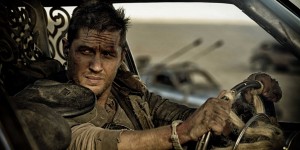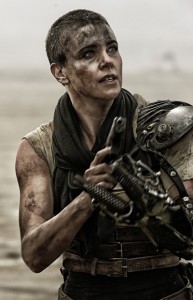Riding the Fury Road
I don’t often see movies as soon as they’re released. I usually prefer to wait until the cinema is a bit less crowded, which takes a few weeks, depending on the movie. I’m fine with that! I’m seldom impatient about these things.
With Mad Max: Fury Road, however, I felt the need to see it sooner rather than later. The amount of internet chatter is was generating was both eye-roll-worthy and intriguing, and I knew I’d get spoiled if I waited too long. I hate spoilers. I was curious to see what all the fuss was about, plus the trailers looked pretty kick-ass. The only solution was to go see it.
[Spoilers ahead, people. You have been warned.]I loved it. The movie was pretty much everything it promised to be: lots of cars, huge chases, explosions, dust, dystopia, leather, and chains. It felt like a Mad Max movie on a fundamental level that is hard to describe. It was grotesque and violent, and weird, and kick-ass, and weirdly hopeful.
They had the balls to make Max more broken than usual, suffering from PTSD at inconvenient times and stumbling through the first half of the movie. He doesn’t speak much, which is something that critics* have complained about, but I don’t remember him speaking much in the first trilogy either. (It has been a while since I’ve seen the old Max movies, but I’m sure he was never a chatty character.)
His personal story is almost subsumed by what is happening around him and the situations he is thrown into; as lead characters go, he’s not one with a lot of agency. He reacts, he works to get himself out of where he is, and he helps those he feels some empathy with along the way because he can’t quite seem to help himself. This also gels with what I remember from those original movies, particularly the third one (who can forget Tina Turner and her iconic chainmail dress; not that he helped her, I just wanted to point it out).
He does have something of a personal journey, though, if you look beyond the explosions and spiky cars. He speaks more towards the end, and one of the more notable times is when he decides to take a more proactive step to help the group he is/was travelling with, by giving them advice about where to go next. He seems to make a kind of peace with his ghosts. At the end, he does something that I don’t think he has done since the first movie: he tells someone his name, and it’s important to him that that someone hears him and knows him. He feels like a less broken character than he was when we started, though he’s still a lone wolf road warrior (I don’t want to give too much away).
It seems to be something of a pattern in things I’ve watched lately: subtle character arcs that you kinda have to be paying attention to spot. Easy to miss in an action movie with a lot of other stuff going on. I love watching the little nuances in character actions and reactions, and I try to pick up on this stuff. Watch closely, people: it’s worth it.
But Max isn’t the brunt of critics’ complaints about Fury Road. He’s a feature of them (he’s the main character and he barely speaks!), as is ‘how dare they abuse a piece of American culture this way’ (which I find hilarious, because it’s an Australian film series currently featuring actors and creators from all over the world). No, the biggest complaint about the movie is what boils down to ‘omg, you got icky girl stuff on my manly action movie‘ (I’m paraphrasing all the ‘you tricked me into watching a feminist movie’ and ‘why girls why’ whining).
In the purest sense of the term, this is a feminist movie, in that women are shown driving, fighting, dying, and kicking ass right alongside the men. Women save other women, and some men. A woman saves Max (and he later saves her right back). Women fight for their own freedom from being sex slaves.
George Miller, director of the franchise, told reporters at Cannes that to rescue the five wives: “I needed a warrior. But it couldn’t be a man taking five wives from another man. That’s an entirely different story. So everything grew out of that.” (Via The Mary Sue.) This explains so much.
The warrior he’s talking about is Imperator Furiosa, played by the ever-awesome Charlize Theron.
Not only does Furiosa have the gall to be a woman, she’s also handicapped (handi-capable? disabled? partially limbed? what’s the PC term these days? wait, no, I don’t care) because she’s missing half an arm. I can’t help but be reminded of Max’s damaged knee that means he has to wear a brace so he can walk properly: the brace is present in the movie but they don’t make a thing of it at all. Furiosa does quite well without a fleshy left hand, thank you very much, and she’s certainly not less capable because of it.
Despite the presence of boobies on her body, she commands respect from the men in her convoy, drives the entire movie forward, and proves herself a capable sniper, driver, and hand-to-stump fighter (she goes head-to-head with Max without her scary-looking metal prosthetic hand and holds her own). She’s a great character, fleshed out with a backstory and personality, and she’s not afraid to stand up and demand the respect she deserves. She kicks ass and gets where she’s going (which in a chase movie is something of an achievement on its own).
She’s not alone in the fierce female ranks, either. The five wives she’s rescuing (from sex-slavery to a grotesque being that it’s best not to contemplate too deeply) are all somewhat soft, but they still pick up guns and other assorted weapons to defend themselves, stand watch, and generally help in the whole endeavour. They are brave and determined, and not one of them whines about needing the protection of a man.
Then there’s the all-female clan that Furiosa is from: tough opposition for anyone in the Mad max world, even though some of them are ageing. They’re survivors, perfectly capable of holding their own, and not above using men’s weaknesses against them.
It’s not just the characters in the movie that do it, though: there are many other ways in which Fury Road is an equalist movie (or feminist, but go with ‘equalist’ if the ‘f’ word is too loaded for you). For example, it starts off with the wives already having been freed; the women are doing their kick-ass thing and Max pretty much blunders into their flight, through no will or action of his own. If you’re interested in more of the movie’s feminist aspects, Tansy Rayner Roberts has done an interesting analysis.
So I can see why the movie is called a feminist masterpiece. I can see why the whiny man-babies are pouting. See it anyway!
From a writer’s perspective, there are many wonderful things about this movie. It turns a lot of standard writing advice on its head, but it does it well – which is the key if you’re going to break rules. Chuck Wendig gives a detailed rundown of just how this movie blows apart the rules, in his usual entertaining, profanity-laden manner.
I think there’s a lot we can all learn from this movie, particularly as writers and artists. Part of what makes it work so well is just how hellishly entertaining it is – it’s a great example of the place I try to hit with my own work, mixing up entertainment and art. Perhaps one day I’ll do a more detailed analysis of the movie from this perspective, most likely after it is released on disc.
So there you go! Like I said: see it. They’ve already announced there will be a sequel, and Tom Hardy has confirmed that he’s signed up for three more movies. Personally, I’m looking forward to them already, whether or not Furiosa is involved.
* By ‘critics’, I mean people who have criticised the movie, not ‘film critics’, who are their own breed.
Comments are closed!

